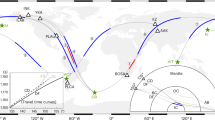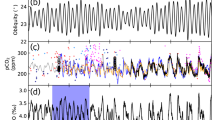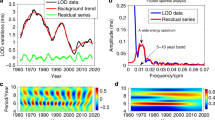Abstract
The motion of the Solar System is chaotic to the extent that the precise positions of the planets are predictable for a period of only about 20 Myr (ref. 1). The Earth's precession, obliquity and insolation parameters over this time period1,2,3,4,5,6 can be influenced by secular variations in the dynamic ellipticity of the planet which are driven by long-term geophysical processes, such as post-glacial rebound5,7,8,9,10. Here we investigate the influence of mantle convection on these parameters. We use viscous flow theory to compute time series of the Earth's dynamic ellipticity for the past 20 Myr and then apply these perturbations to the nominal many-body orbital solution of Laskar et al.5. We find that the convection-induced change in the Earth's flattening perturbs the main frequency of the Earth's precession into the resonance associated with a secular term in the orbits of Jupiter and Saturn5, and thus significantly influences the Earth's obliquity. We also conclude that updated time series of high-latitude summer solar insolation diverge from the nominal solution for periods greater than the past ∼5 Myr. Our results have implications both for obtaining precise solutions for precession and obliquity and for procedures that adopt astronomical calibrations to date sedimentary cycles and climatic proxy records.
This is a preview of subscription content, access via your institution
Access options
Subscribe to this journal
Receive 51 print issues and online access
$199.00 per year
only $3.90 per issue
Buy this article
- Purchase on Springer Link
- Instant access to full article PDF
Prices may be subject to local taxes which are calculated during checkout




Similar content being viewed by others
References
Laskar, J. The chaotic motion of the solar system: A numerical estimate of the size of the chaotic zones. Icarus 88, 266–291 (1990).
Laskar, J. Secular evolution of the solar system over 10 million years. Astron. Astrophys. 198, 341–362 (1988).
Berger, A. & Loutre, M. F. Insolation values for the climate of the last 10 m.y. Quat. Sci. Rev. 10, 297–317 (1991).
Quinn, T. R., Tremaine, S. & Duncan, M. Athree million year integration of the Earth's orbit. Astron. J. 101, 2287–2305 (1991).
Laskar, J., Joutel, F. & Boudin, F. Orbital, precessional, and insolation quantities for the Earth from −20 Myr to +10 Myr. Astron. Astrophys. 270, 522–533 (1993).
Sussman, S. J. & Wisdom, J. Chaotic evolution of the solar system. Science 257, 56–62 (1992).
Dehant, V., Loutre, M.-F. & Berger, A. Potential impact of the northern hemisphere Quaternary ice sheets on the frequencies of the astroclimatic orbital parameters. J. Geophys. Res. 95, 7573–7578 (1990).
Mitrovica, J. X., Pan, R. & Forte, A. M. Late Pleistocene and Holocene ice mass fluctuations and the Earth's precession constant. Earth Planet. Sci. Lett. 128, 489–500 (1994).
Mitrovica, J. X. & Forte, A. M. Pleistocene glaciation and the Earth's precession constant. Geophys. J. Int. 121, 21–32 (1995).
Mitrovica, J. X., Forte, A. M. & Pan, R. Glaciation-induced variations in the Earth's precession frequency, obliquity and insolation over the last 2.6 Ma. Geophys. J. Int. 128, 270–284 (1997).
Forte, A. M. & Peltier, W. R. Viscous flow models of global geophysical observables. 1. Forward problems. J. Geophys. Res. 96, 20131–20159 (1991).
Glatzmaier, G. A. Numerical simulations of stellar convective dynamos. 1. The model and method. J. Comp. Phys. 55, 461–484 (1984).
Steinberger, B. M. & O'Connell, R. J. Changes in the Earth's rotation axis inferred from advection of mantle density heterogeneities. Nature 387, 169–173 (1997).
Gordon, R. J. & Jurdy, D. M. Cenozoic global plate motions. J. Geophys. Res. 91, 12389–12406 (1986).
Richards, M. A. & Engebretson, D. C. Large-scale mantle convection and the history of subduction. Nature 355, 437–440 (1992).
Ricard, Y., Richards, M. A., Lithgow-Bertelloni, C. & Le Stunff, Y. Ageodynamic model of mantle density heterogeneity. J. Geophys. Res. 98, 21895–21909 (1993).
Richards, M. A., Ricard, Y., Lithgow-Bertelloni, C., Spada, G. & Sabadini, R. An explanation for Earth's long-term rotational stability. Science 275, 372–375 (1997).
Spada, G., Ricard, Y. & Sabadini, R. Excitation of true polar wander by subduction. Nature 360, 452–454 (1992).
Forte, A. M., Woodward, R. L. & Dziewonski, A. M. Joint inversions of seismic and geodynamic data for models of three-dimensional mantle heterogeneity. J. Geophys. Res. 99, 21857–21877 (1994).
Karato, S.-I. Importance of anelasticity in the interpretation of seismic tomography. Geophys. Res. Lett. 20, 1623–1626 (1993).
Forte, A. M., Mitrovica, J. X. & Woodward, R. L. Seismic-geodynamic determination of the origin of excess ellipticity of the core-mantle boundary. Geophys. Res. Lett. 22, 1013–1016 (1995).
Mitrovica, J. X. & Forte, A. M. Radial profile of mantle viscosity: results from the joint inversion of convection and postglacial rebound observations. J. Geophys. Res. 102, 2751–2769 (1997).
Imbrie, J. Astronomical theory of the Pleistocene ice ages: A brief historical review. Icarus 50, 408–422 (1982).
Lourens, L. J. et al.Evaluation of the Plio-Pleistocene astronomical timescale. Paleoceanography 11, 391–413 (1996).
Néron de Surgy, O. & Laskar, J. On the long term evolution of the spin of the Earth. Astron. Astrophys. 318, 975–989 (1997).
Forte, A. M., Dziewonski, A. M. & Woodward, R. L. Aspherical structure of the mantle, tectonic plate motions, nonhydrostatic geoid, and topography of the core–mantle-boundary, in Dynamics of the Earth's Deep Interior and Earth Rotation (ed. Le-Mouel, J.-L., Smylie, D. E. & Herring, T.) 135–166 (Geophys. Monogr. 72, AGU, Washington, DC, (1993)).
Li, X.-D. & Romanowicz, B. Global mantle shear-velocity model developed using nonlinear asymptotic coupling theory. J. Geophys. Res. 101, 22245–22272 (1996).
Masters, G., Johnson, S., Laske, G. & Bolton, H. Ashear-velocity model of the mantle. Phil. Trans. R. Soc. Lond. A 354, 1385–1411 (1996).
Acknowledgements
We thank K. Cheng, S. Shettleworth, S. Yoerg, J. Templeton, A. Bond, K. Gould-Beierle, B. Gibson and C. Cink for comments on previous drafts of this paper, and D. W. Stephens for assistance with data analysis. The research was supported by The National Science Foundation and the Howard Hughes Medical Institute.
Author information
Authors and Affiliations
Corresponding author
Rights and permissions
About this article
Cite this article
Forte, A., Mitrovica, J. A resonance in the Earth's obliquity and precession overthe past 20 Myr drivenbymantle convection. Nature 390, 676–680 (1997). https://doi.org/10.1038/37769
Received:
Accepted:
Published:
Issue Date:
DOI: https://doi.org/10.1038/37769
This article is cited by
Comments
By submitting a comment you agree to abide by our Terms and Community Guidelines. If you find something abusive or that does not comply with our terms or guidelines please flag it as inappropriate.



